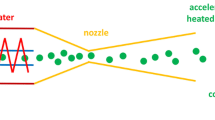Abstract
Numerical simulations of gas/particle flows of cold spray are performed for N2 and He, respectively, to investigate the usefulness of the two material-independent combination parameters derived from the equations of particle motion and temperature. The first combination parameter is the particle-diameter multiplied by the material density, which governs the particle velocity. The second one is the squared particle-diameter multiplied by the material density and specific heat, which affects the particle temperature. In the numerical simulation, the materials of the spray particle selected are WC-12Co, Cu and Ti. The numerical results show that the maximum impact velocity of particle is obtained, when the first combination parameter takes specific value regardless of the material type. Furthermore, it is shown that the particle diameter and its temperature corresponding to the maximum impact velocity can be graphically estimated by using the two combination parameters for any powder-materials normally used for the thermal spray.







Similar content being viewed by others
Abbreviations
- A p :
-
Projected area of particle
- A s :
-
Surface area of particle
- c d :
-
Drag coefficient of particle
- c p :
-
Specific heat of gas at constant pressure
- C :
-
Specific heat of the particle
- d p :
-
Particle diameter
- \( d^{ * }_{{\text{p}}} \) :
-
Particle diameter at maximum impact-velocity
- f prop :
-
Correction factor for thermal boundary-layer
- k g :
-
Thermal conductivity of gas
- m p :
-
Mass of particle
- M g :
-
Gas Mach number
- M p :
-
Particle Mach number
- N u :
-
Nusselt number
- P r :
-
Prandtl number of gas
- Re p :
-
Particle Reynolds number
- T f :
-
Film temperature
- T g :
-
Gas temperature
- T p :
-
Particle temperature
- \( T^{ * }_{{\text{p}}} \) :
-
Particle temperature at maximum impact-velocity
- u g :
-
Gas velocity
- u p :
-
Particle velocity
- u pi :
-
Particle impact-velocity
- \( u^{ * }_{{{\text{pi}}}} \) :
-
Maximum particle impact-velocity
- x :
-
Axial distance along center line from nozzle exit
- α:
-
Heat transfer coefficient
- γ:
-
Specific heat ratio
- μg :
-
Gas viscosity
- ρg :
-
Gas density
- ρp :
-
Particle density
References
T. Stoltenhoff, H. Kreye, H.J. Richter, An Analysis of the Cold Spray Process and Its Coatings, J. Thermal Spray Technol., Vol 11 (No. 4), 2002, p 542-550
T. Marrocco, D.G. McCartney, P.H. Shipway, A.J. Sturgeon, Production of Titanium Deposits by Cold-Gas Dynamic Spray: Numerical Modeling and Experimental Characterization, J. Thermal Spray Technol., Vol 15 (No. 2), 2006, p 263-272
M. Karimi, A. Fartaj, G. Rankin, D. Vanderzwet, W. Birtch, J. Villafuerte, Numerical Simulation of the Cold Gas Dynamic Spray Process, J. Thermal Spray Technol., Vol 15 (No. 4), 2006, p 518-523
W.-Y. Li, C.-J. Li, Optimal Design of a Novel Cold Spray Gun Nozzle at a Limited Space, J. Thermal Spray Technol., Vol 14 (No. 3), 2005, p 391-396
R.C. Dykhuizen and R.A. Neiser, Optimizing the Cold Spray Process, Thermal Spray 2003: Advancing the Science and Applying the Technology, B.R. Marple and C. Moreau, Eds., May 5-8, 2003 (Orlando, FL, USA) ASM International, Materials Park, OH, 2003, p 19-26
B. Jodoin, Cold Spray Nozzle Mach Number Limitation, J. Thermal Spray Technol., Vol 11 (No. 4), 2002, p 496-507
H.C. Yee, Upwind and Symmetric Shock-Capturing Schemes, NASA TM-89464, 1987, 127 pp
M.J. Zucrow, J.D. Hoffman, Gas Dynamics, John Wiley & Sons, NY, (1976) p 160-181
H.D. Kim, K. Matsuo, T. Setoguchi, Investigation on Onset of Shock-Induced Separation, Shock Waves, Vol 6 (No. 5), 1996, p 275-286
A.B. Bailey, J. Hiatt, Sphere Drag Coefficient for a Broad Range of Mach and Reynolds Numbers, AIAA J., Vol 10 (No. 11), 1972, p 1436-1440
Y.P. Wan, V. Prasad, G.-X. Wang, S. Sampath, J.R. Fincke, Model and Powder Particle Heating, Melting, Resolidification, and Evaporation in Plasma Spraying Processes, J. Heat Transfer, Vol 121 (No. 3), 1999, p 691-699
Author information
Authors and Affiliations
Corresponding author
Additional information
This article is an invited paper selected from presentations at the 2007 International Thermal Spray Conference and has been expanded from the original presentation. It is simultaneously published in Global Coating Solutions, Proceedings of the 2007 International Thermal Spray Conference, Beijing, China, May 14-16, 2007, Basil R. Marple, Margaret M. Hyland, Yuk-Chiu Lau, Chang-Jiu Li, Rogerio S. Lima, and Ghislain Montavon, Ed., ASM International, Materials Park, OH, 2007.
Rights and permissions
About this article
Cite this article
Katanoda, H., Fukuhara, M. & Iino, N. Numerical Study of Combination Parameters for Particle Impact Velocity and Temperature in Cold Spray. J Therm Spray Tech 16, 627–633 (2007). https://doi.org/10.1007/s11666-007-9087-7
Received:
Revised:
Accepted:
Published:
Issue Date:
DOI: https://doi.org/10.1007/s11666-007-9087-7




